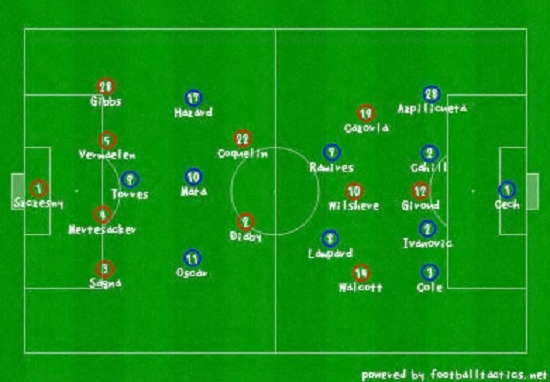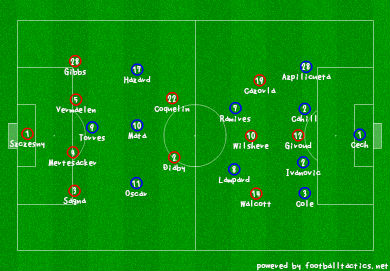On a snowy Sunday evening, Chelsea took on Arsenal at Stamford Bridge in a big London derby. Both teams needed the points to aid and abet their chase for the European spots. Chelsea came into this game on the back of some poor home form and a disappointing draw against Southampton in midweek. Arsenal also entered the game in mixed form and there was all to play for as the teams took to the field.
Chelsea
Benitez set his side up to play a high tempo counter attacking game as a response to Arsenal’s possession based football. This tactic was effective as both Chelsea goals came from quick breaks away after Arsenal had lost possession. In terms of defense, the Chelsea side seemed to consciously try and narrow down the spaces between their defense and play a sort of offside trap in order to stop Arsenal playing through balls. This tactic may be slightly confusing, and it required some excellent execution from Cahill and Ivanovic. The defense sat deeper, so as to draw Arsenal higher up the pitch, but all three lines were very close together, squeezing the game, and consequently any space for Arsenal. The Chelsea back line which sat on the edge of their area, often moved forward as Arsenal attackers received the ball in the final third so as to pressurize them to play their through balls quicker. This resulted in a large number of offside decisions going against the Gunners, but also gave them a few good chances (Giroud) and a goal (Walcott).
The full backs were also narrower and rarely ventured away from the wide edges of the penalty area. This restricted the space required for through balls between the full back and center back. It also conceded the wide areas to the away team, but Ivanovic and Cahill successfully dealt with the threat of Giroud (who was very wasteful).
The rest of the team was instructed to press Arsenal hard, especially the midfielders. Abou Diaby, especially, was hounded endlessly in the first half. The emphasis on winning the ball back quickly was there to see, as Chelsea wanted to stem the counter attacks and stop Arsenal exploiting the pace of Walcott, who has hurt them in the past. This is evidenced by how many times Chelsea won the ball high up the pitch, keeping pressure on the fragile Arsenal defense.
The attacking midfielders also tracked back a lot more, and put in a good shift. Eden Hazard must be singled out for praise as he worked very hard.
Chelsea set themselves up to play on the break. The passing was direct in nature, and the aim was to get the ball to the ‘3 Amigos’, Oscar, Hazard and Mata as soon as possible. The aforementioned did not disappoint with a lot of through balls ripping through the Arsenal defense. The quick counter attacks led to lots of open spaces, and these were exploited to good effect, especially by the likes of Mata, and Ramires.
Another aspect was the large amount of diagonal balls played by the full backs. The rationale behind doing so was to exploit the poor positioning of both Gibbs and Sagna. It worked very well for the first goal, as Bakary Sagna was caught out of position, and Mata occupied his spot to find time and space to apply the finish. Kieron Gibbs too, had a torrid time in the first half, especially when he was forced to defend against the excellent Eden Hazard.
Fernando Torres, who has been the target of a lot of criticism since his arrival at Chelsea, played very well, and justified his inclusion ahead of Demba Ba. Playing in the role of the pivot, Torres, as he has been at his time at Stamford Bridge, was excellent in his play outside the penalty box. He linked play very well, brought his midfielders into the game a lot of times, and made intelligent runs to occupy defenders, allowing the runners like Ramires and Lampard to surge forward. All in all, he has every right to go home with a smile on his face today.
Another striking aspect in Chelsea’s play was the break neck speed of the attacks. Obviously, Benitez has noticed the illness that affected Chelsea during the torrid home run where the team lost twice and threw away a sizeable lead to Southampton, and has instructed his players to remedy it. The effects were devastating as Chelsea created a number of chances and constantly had the Arsenal defense on their toes.
Over the last 2 months, Chelsea have had an insane schedule, playing 3 games a week, almost every week. This has started to take a toll on the players, and has affected their ability to perform consistently over 90 minutes. In their games against Swansea, QPR and Southampton, Chelsea conceded second half goals. Even today, the drop in the energy levels in the second half was evident, as Chelsea were unable to press with the same vigor, thereby allowing Arsenal back into the game (the Gunners also raised their game, but were helped by Chelsea’s inefficiency). Eden Hazard was particularly affected with some very tired challenges towards the end showing him up. This fatigue contributed to the reduced counter attacking ability in the second half, allowing pressure to build on their defense, which just about held on.
ARSENAL
For the latest installment of the London derby between Arsenal and Chelsea, Arsene Wenger’s team stuck to their customary 4-2-3-1 formation. Aside from youngster Francis Coquelin in central midfield and Santi Cazorla featuring on the left, there were no major surprises in the personnel deployed by the North London team. For most of the first half the Gunners were outplayed by their counterparts as they chose to sit deep and playing on the counter. Only in the second half, when they played with an increased tempo and higher up the field did they outplay their opponents. Arsenal’s wide men, Theo Walcott and Santi Cazorla like most modern day wingers, showed a tendency to drift infield rather than the old fashioned method of hugging the touchlines. This tactic led to the first real chance of the game as Olivier Giroud flashed a shot wide in the 5th minute after being played in. Santi Cazorla’s shot in the 9th minute was also a result of him drifting infield. Unfortunately this was pretty much the extent of their attacking impetus in the first half. This eventually led to Arsenal’s only goal of the game as Cazorla played Walcott in with a precise through ball, and the England international put his chance away tidily.
A by-product of the above mentioned tactic led to the creation of space for full backs, Sagna and Gibbs to run into. While this provided Arsenal’s attack with width, Arsenal’s uncharacteristic sloppiness in possession (more on that later) resulted in gaps in their defence which was duly punished by Chelsea’s attack. For the first goal, Arsenal were unlucky as a foul on Coquelin in the buildup was missed by the referee, however when Chelsea got the ball Sagna was caught up field and even though he tried to his best to recover, his initial position left too big a gap between him and Mertesacker which Mata made full use of. The move which led to the awarding of the penalty for Chelsea’s second was another instance where the space between the full back and central defence was utilized.  Much of Arsenal’s problems in the first half were of their own making. Wave after wave of Chelsea attacks pushed them on the back foot. The fact that Arsenal found it hard to hold on to the ball, made sure that their defence had little respite. Players across the midfield were guilty of losing the ball repeatedly which invited pressure on to the defence and in turn forced Arsenal to drop deeper as a team thus isolating Giroud. In fact the move that culminated in the penalty awarded to Chelsea started with Diaby being caught in possession in his own half. Chelsea dominated possession for almost the entirety of the half with Arsenal offering little attacking threat in return. Chelsea’s movement and passing were a constant thorn in Arsenal’s flesh with Arsenal’s defence also being outnumbered.
Much of Arsenal’s problems in the first half were of their own making. Wave after wave of Chelsea attacks pushed them on the back foot. The fact that Arsenal found it hard to hold on to the ball, made sure that their defence had little respite. Players across the midfield were guilty of losing the ball repeatedly which invited pressure on to the defence and in turn forced Arsenal to drop deeper as a team thus isolating Giroud. In fact the move that culminated in the penalty awarded to Chelsea started with Diaby being caught in possession in his own half. Chelsea dominated possession for almost the entirety of the half with Arsenal offering little attacking threat in return. Chelsea’s movement and passing were a constant thorn in Arsenal’s flesh with Arsenal’s defence also being outnumbered.
Arsenal’s left hand side was also a cause for concern as the attack minded Cazorla shied away from his defensive duties on occasion which lead to two on one situations. Lampard and Ramires who occupied deeper positions in the Chelsea midfield often switched play wide leading to the exposure of Arsenal’s flanks. The phrase that football is a game of two halves may be a cliché, but like most other clichés it is unequivocally true. The same players might have come out for the second half but they were a completely different side.
Playing with a greater tempo, Arsenal now bossed midfield. Diaby and Coquelin found a strong foothold in the game. Coquelin in particular, showed energy in the middle of the park until injury curtailed his participation in the game. Arsenal as a team pushed higher up the field and posed a greater attacking threat as compared to the first half. Saying that they lacked the cutting edge in attack and though they pulled a goal back through Walcott, they couldn’t find the equalizer. They did knock on Chelsea’s door towards the end of the game especially with a series of corners in stoppage time but Chelsea’s defence kept them out. Arsenal came out with an improved display in the second half, but the damage was done in the first where they were thoroughly outplayed. The margin of defeat could have been bigger had Chelsea been more proficient on the counter. Follow @ArnabRay21
Graphical illustrations taken from Squawka with their prior permission and as per their provided guidelines.
Click here to view our other Tactical Analysis articles.






























































